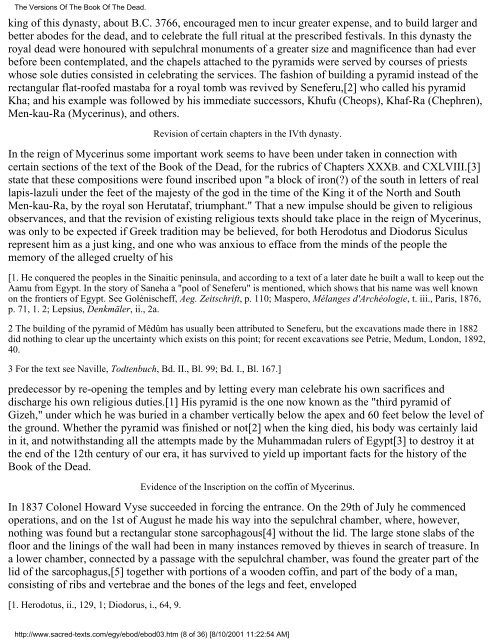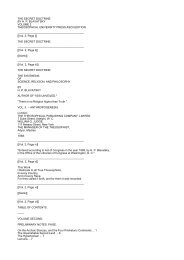You also want an ePaper? Increase the reach of your titles
YUMPU automatically turns print PDFs into web optimized ePapers that Google loves.
The Versions Of The <strong>Book</strong> Of The <strong>Dead</strong>.<br />
king <strong>of</strong> this dynasty, about B.C. 3766, encouraged men to incur greater expense, and to build larger and<br />
better abodes for <strong>the</strong> dead, and to celebrate <strong>the</strong> full ritual at <strong>the</strong> prescribed festivals. In this dynasty <strong>the</strong><br />
royal dead were honoured with sepulchral monuments <strong>of</strong> a greater size and magnificence than had ever<br />
before been contemplated, and <strong>the</strong> chapels attached to <strong>the</strong> pyramids were served by courses <strong>of</strong> priests<br />
whose sole duties consisted in celebrating <strong>the</strong> services. The fashion <strong>of</strong> building a pyramid instead <strong>of</strong> <strong>the</strong><br />
rectangular flat-ro<strong>of</strong>ed mastaba for a royal tomb was revived by Seneferu,[2] who called his pyramid<br />
Kha; and his example was followed by his immediate successors, Khufu (Cheops), Khaf-Ra (Chephren),<br />
Men-kau-Ra (Mycerinus), and o<strong>the</strong>rs.<br />
Revision <strong>of</strong> certain chapters in <strong>the</strong> IVth dynasty.<br />
In <strong>the</strong> reign <strong>of</strong> Mycerinus some important work seems to have been under taken in connection with<br />
certain sections <strong>of</strong> <strong>the</strong> text <strong>of</strong> <strong>the</strong> <strong>Book</strong> <strong>of</strong> <strong>the</strong> <strong>Dead</strong>, for <strong>the</strong> rubrics <strong>of</strong> Chapters XXXB. and CXLVIII.[3]<br />
state that <strong>the</strong>se compositions were found inscribed upon "a block <strong>of</strong> iron(?) <strong>of</strong> <strong>the</strong> south in letters <strong>of</strong> real<br />
lapis-lazuli under <strong>the</strong> feet <strong>of</strong> <strong>the</strong> majesty <strong>of</strong> <strong>the</strong> god in <strong>the</strong> time <strong>of</strong> <strong>the</strong> King it <strong>of</strong> <strong>the</strong> North and South<br />
Men-kau-Ra, by <strong>the</strong> royal son Herutataf, triumphant." That a new impulse should be given to religious<br />
observances, and that <strong>the</strong> revision <strong>of</strong> existing religious texts should take place in <strong>the</strong> reign <strong>of</strong> Mycerinus,<br />
was only to be expected if Greek tradition may be believed, for both Herodotus and Diodorus Siculus<br />
represent him as a just king, and one who was anxious to efface from <strong>the</strong> minds <strong>of</strong> <strong>the</strong> people <strong>the</strong><br />
memory <strong>of</strong> <strong>the</strong> alleged cruelty <strong>of</strong> his<br />
[1. He conquered <strong>the</strong> peoples in <strong>the</strong> Sinaitic peninsula, and according to a text <strong>of</strong> a later date he built a wall to keep out <strong>the</strong><br />
Aamu from Egypt. In <strong>the</strong> story <strong>of</strong> Saneha a "pool <strong>of</strong> Seneferu" is mentioned, which shows that his name was well known<br />
on <strong>the</strong> frontiers <strong>of</strong> Egypt. See Golénischeff, Aeg. Zeitschrift, p. 110; Maspero, Mélanges d'Archéologie, t. iii., Paris, 1876,<br />
p. 71, 1. 2; Lepsius, Denkmäler, ii., 2a.<br />
2 The building <strong>of</strong> <strong>the</strong> pyramid <strong>of</strong> Mêdûm has usually been attributed to Seneferu, but <strong>the</strong> excavations made <strong>the</strong>re in 1882<br />
did nothing to clear up <strong>the</strong> uncertainty which exists on this point; for recent excavations see Petrie, Medum, London, 1892,<br />
40.<br />
3 For <strong>the</strong> text see Naville, Todtenbuch, Bd. II., Bl. 99; Bd. I., Bl. 167.]<br />
predecessor by re-opening <strong>the</strong> temples and by letting every man celebrate his own sacrifices and<br />
discharge his own religious duties.[1] His pyramid is <strong>the</strong> one now known as <strong>the</strong> "third pyramid <strong>of</strong><br />
Gizeh," under which he was buried in a chamber vertically below <strong>the</strong> apex and 60 feet below <strong>the</strong> level <strong>of</strong><br />
<strong>the</strong> ground. Whe<strong>the</strong>r <strong>the</strong> pyramid was finished or not[2] when <strong>the</strong> king died, his body was certainly laid<br />
in it, and notwithstanding all <strong>the</strong> attempts made by <strong>the</strong> Muhammadan rulers <strong>of</strong> Egypt[3] to destroy it at<br />
<strong>the</strong> end <strong>of</strong> <strong>the</strong> 12th century <strong>of</strong> our era, it has survived to yield up important facts for <strong>the</strong> history <strong>of</strong> <strong>the</strong><br />
<strong>Book</strong> <strong>of</strong> <strong>the</strong> <strong>Dead</strong>.<br />
Evidence <strong>of</strong> <strong>the</strong> Inscription on <strong>the</strong> c<strong>of</strong>fin <strong>of</strong> Mycerinus.<br />
In 1837 Colonel Howard Vyse succeeded in forcing <strong>the</strong> entrance. On <strong>the</strong> 29th <strong>of</strong> July he commenced<br />
operations, and on <strong>the</strong> 1st <strong>of</strong> August he made his way into <strong>the</strong> sepulchral chamber, where, however,<br />
nothing was found but a rectangular stone sarcophagous[4] without <strong>the</strong> lid. The large stone slabs <strong>of</strong> <strong>the</strong><br />
floor and <strong>the</strong> linings <strong>of</strong> <strong>the</strong> wall had been in many instances removed by thieves in search <strong>of</strong> treasure. In<br />
a lower chamber, connected by a passage with <strong>the</strong> sepulchral chamber, was found <strong>the</strong> greater part <strong>of</strong> <strong>the</strong><br />
lid <strong>of</strong> <strong>the</strong> sarcophagus,[5] toge<strong>the</strong>r with portions <strong>of</strong> a wooden c<strong>of</strong>fin, and part <strong>of</strong> <strong>the</strong> body <strong>of</strong> a man,<br />
consisting <strong>of</strong> ribs and vertebrae and <strong>the</strong> bones <strong>of</strong> <strong>the</strong> legs and feet, enveloped<br />
[1. Herodotus, ii., 129, 1; Diodorus, i., 64, 9.<br />
http://www.sacred-texts.com/egy/ebod/ebod03.htm (8 <strong>of</strong> 36) [8/10/2001 11:22:54 AM]

















